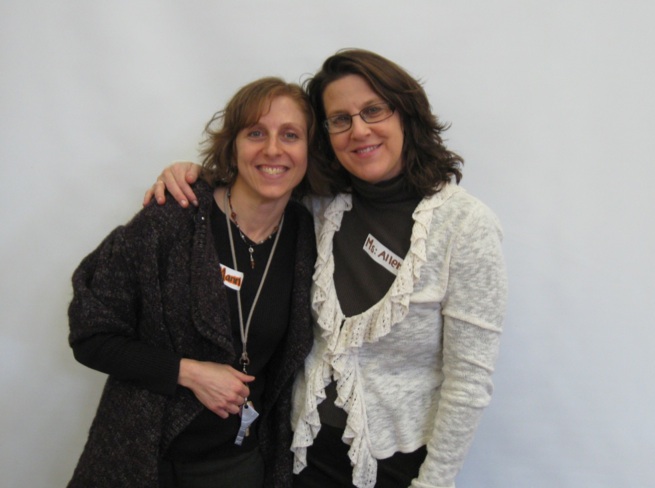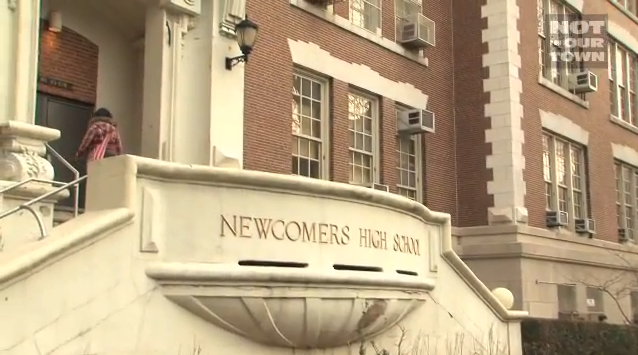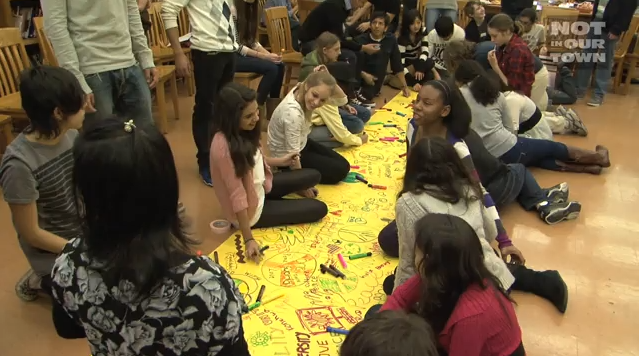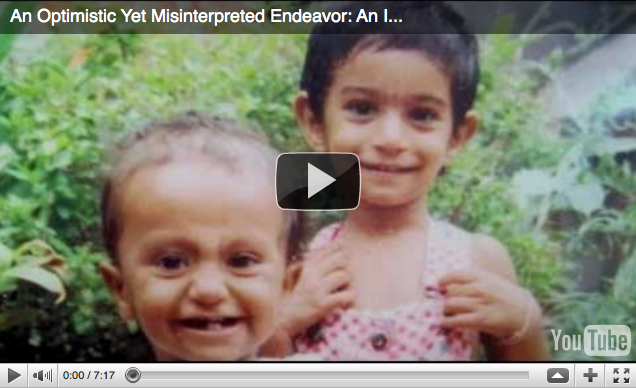
Teachers Julie Mann (left) and Kim Allen (right)
—Julie Mann, Newcomers High School teacher
The shock and sadness following the murder of Ecuadorian immigrant Marcelo Lucero reverberated far beyond Patchogue, N.Y., where the crime occurred. In Julie Mann’s classroom, some 60 miles away in Long Island City, N.Y., her students felt confused and angered by Lucero’s death and other acts of anti-immigrant violence.
Sixteen years ago, Mann began her teaching career at Newcomers High School, which specializes in teaching new Americans. She currently teaches a human rights class that often delves into the human rights issues in her students’ native countries. The Building Bridges project, which we chronicled in our new film, “New Immigrants Share Their Stories,” evolved as a positive response to the issues sparked by Lucero’s murder.
Mann and her Building Bridges project partner Kim Allen are Facing History and Ourselves teachers. Newcomers High School was named one of the top 10 high schools by U.S. News & World Report in 2008. Last week, Mann took the time to discuss her students’ response to anti-immigrant violence, how they recount their own journeys to the U.S., and the value immigrants add to this country.

NIOT: I understand that Newcomers High School specializes in immigrant students. Can you tell me a little bit about the high school, your students, and how you began teaching there?
JM: We have students from all over the world speaking many different languages. I began teaching there the year it opened, while getting my masters in TESOL (Teaching English to speakers of other languages).
NIOT: Because it's such a specific population, does it change the way you teach?
JM: Yes, of course. Firstly, all of my students are ELL's (English Language Learners), so I have to constantly think about level of materials, additional context I might have to provide, cultural sensitivities, etc. And because my students are such a rich source of information, their cultures, languages and backgrounds often inform how I structure curriculum.
NIOT: Do the students find their mutual immigration histories—through they vary widely—to be a common experience?
JM: Absolutely. In the beginning, when their English skills are minimal, they tend to stay in language groups. But after a very short time, they make friends with students from all over the world. Their shared experience as immigrants makes for a very quick bond.
NIOT: Why do you think it's important for students to learn about human rights issues in high school?
JM: I think that the earlier students learn that they can become agents of change, the more likely they will do just that. My class is about taking action—doing community service, writing letters in support of or against issues, leading peer-education sessions, etc. Further, my students are often stigmatized due to their immigration status. Being in this class helps them see that they can have a voice, that they are powerful and that they can effect change.


NIOT: As you know, we have been working on a documentary that details the community of Patchogue, NY after the murder of Ecuadorian immigrant, Marcelo Lucero. Patchogue is not far from your school and I was deeply touched by your students letters to Joselo Lucero, Marcelo's brother who has spoken frequently about the need to stop such hateful actions. As one student said, "You lost Marcelo but you also gained us as family." Could you speak to how your students reacted to the news of Marcelo Lucero's murder and other acts of anti-immigrant violence?
JM: My students were shocked, saddened and angered by both Marcelo Lucero's murder and the general hatred/abuse of immigrants. They felt it was unfair to be seen as a threat when they have come here for a better life, but also to add to our society. The US is a country of immigrants, so any anti-immigrant sentiments are confusing and upsetting to them. Also, immigration, especially for a teenager, is traumatic no matter what. So this wave of violence only adds to their fears and homesickness.
At the same time, the Building Bridges project really helped them process these emotions in a positive way. Also, getting attention from their St Luke's buddies and from NIOT really helped affirm for them that it's possible to change people's perceptions of immigrants and that they were making a difference.
NIOT: You and your students have generously offered other materials from the Building Bridges project, namely several student video diaries detailing your students’ own journeys to the U.S., which are personal and powerful. How did the video portion of this project come into being and what were your goals? Did your students enjoy using this medium? And did it change the way they told their stories?
 JM: When I created the Building Bridges project, I initially wanted it to be a completely video-based project. However, in talking with Diane Kandel, the media teacher who helped my students create their digital diaries, I realized that I probably couldn't have 34 students create videos. But I knew I could have them all write their stories and that these written pieces could lead to other mediums. Once the students had their pieces written, six were chosen for video.
JM: When I created the Building Bridges project, I initially wanted it to be a completely video-based project. However, in talking with Diane Kandel, the media teacher who helped my students create their digital diaries, I realized that I probably couldn't have 34 students create videos. But I knew I could have them all write their stories and that these written pieces could lead to other mediums. Once the students had their pieces written, six were chosen for video. These six students did enjoy using the medium of film, but they also had challenges and needed to persevere. Making movies is no small task.
NIOT: Finally, one of the things we address in our upcoming film on Patchogue is anti-immigrant rhetoric. Immigration is undeniably a controversial issue in our country right now, but there seems to be a desire to change the conversation on immigration so it is less damaging and more productive. In your opinion, what conversation on immigration is worth having nationwide?
JM: We are all either immigrants, children of immigrants, grandchildren of immigrants, etc. So first, I think that needs to be recognized and embraced. From there I would love to see our country focus on the value immigrants are adding to our country. The more people can see that being a diverse nation of people is what makes our country special and strong, the fewer who will see immigrants as a threat. Our motivation for the Building Bridges project was just that—share our stories so that non-immigrants will see how motivated, strong, unique, and worthy my students are.
To find our more about the Newcomers High School-St. Luke’s Building Bridges Project, visit NotInOurSchool.org/Newcomers. The Not In Our Town film that focuses on the community response to the Lucero murder will air on PBS on Sept. 21, 2011. For more information on the film, visit NIOT.org/LightInThe Darkness.